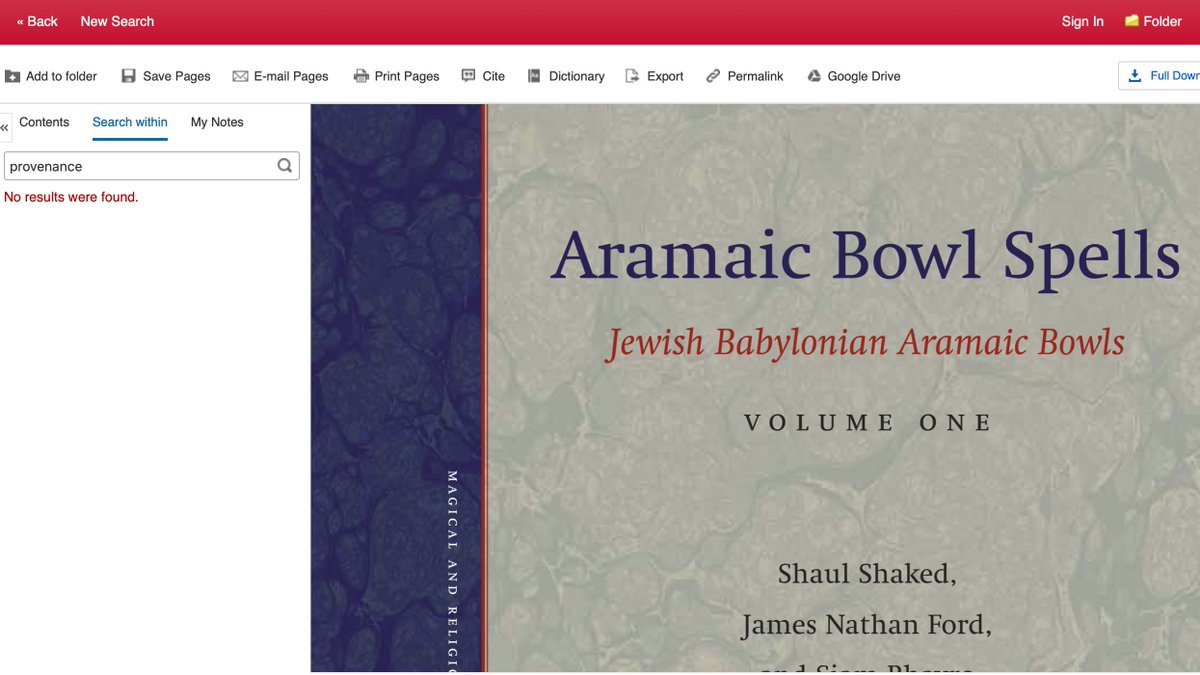How does Shaked/Ford/Bhayro's 2013 publication of the Schøyen Collection Aramaic incantation bowls deal with provenance? This is an interesting case, worth looking at a bit.
From the EBSCOhost ebook, it would seem the word "provenance" doesn't occur in the book . . .
From the EBSCOhost ebook, it would seem the word "provenance" doesn't occur in the book . . .
https://twitter.com/arsteinjustnes/status/1411922682938068993

But in fact this appears to be a case of poorly-done OCR, as the word does occur.
We find it on (at least) one page of the text, though here it refers to ancient provenience, not to modern findspot or collection history. 

There we see a reference to the geographic origin of the bowls: mainly Mesoptamia, but (perhaps surprisingly) a definitive claim that some come from Iran. 

But the reference to a geographic region (Khuzistan) combined with a more tentative localization at a specific site ("perhaps more specifically in Susa") raises a red flag -- it doesn't sound like we're dealing with anything found in archaeological excavation.
So what evidence does the reference provide?
An old personal communication (from "some years ago") that couldn't be substantiated, and 1 further reference to "incantation bowls excavated in Iran"
An old personal communication (from "some years ago") that couldn't be substantiated, and 1 further reference to "incantation bowls excavated in Iran"

The reference is to Cyrus Gordon, "Two Magic Bowls in Teheran", Orientalia 20 (1951).
Here is the relevant text:
Here is the relevant text:

Gordon cites a total of 4 bowls, only 2 Aramaic (the other 2 Mandaic): 1 Aramaic bowl was in an Iranian private collection, the other a fragment in the Tehran museum that Gordon says was "excavated in Khuzistan".
What does this mean? It means that this is really shoddy evidence!
What does this mean? It means that this is really shoddy evidence!
It's remarkable that the authors of our 2013 text would represent this as a reference to "bowls" (plural) "excavated in Iran" -- or make a definitive statement about origins in Iran on the basis of any of this evidence.
Instead, Neil Brodie ("The market background to the April 2003 plunder of the Iraq National Museum", 2008) would seem to have a more precise summary: some bowls *possibly* originated in Iran, but none can be *documented* as such.
traffickingculture.org/publications/b…
traffickingculture.org/publications/b…

So why would scholars make such an effort to claim definitively that some bowls come from Iran?
Brodie provides an answer for that, too: In this case, because of a UN Security Council resolution wrt Iraq, Schøyen used the claim to try to avoid forfeiting his bowls!
Brodie provides an answer for that, too: In this case, because of a UN Security Council resolution wrt Iraq, Schøyen used the claim to try to avoid forfeiting his bowls!

So it is perhaps not coincidental that this 2013 book making unsupported claims of proven origins in Iran is a publication of incantation bowls from the Schøyen Collection. 

In other words, the authors are not only working with almost certainly looted & smuggled material, & increasing value (and therefore incentives for further looting), but they also appear to be making dubious provenance claims in order to justify the owner's continued possession.
For further background: traffickingculture.org/publications/b…
https://twitter.com/RichardBott7/status/1411971892387352580
• • •
Missing some Tweet in this thread? You can try to
force a refresh


















